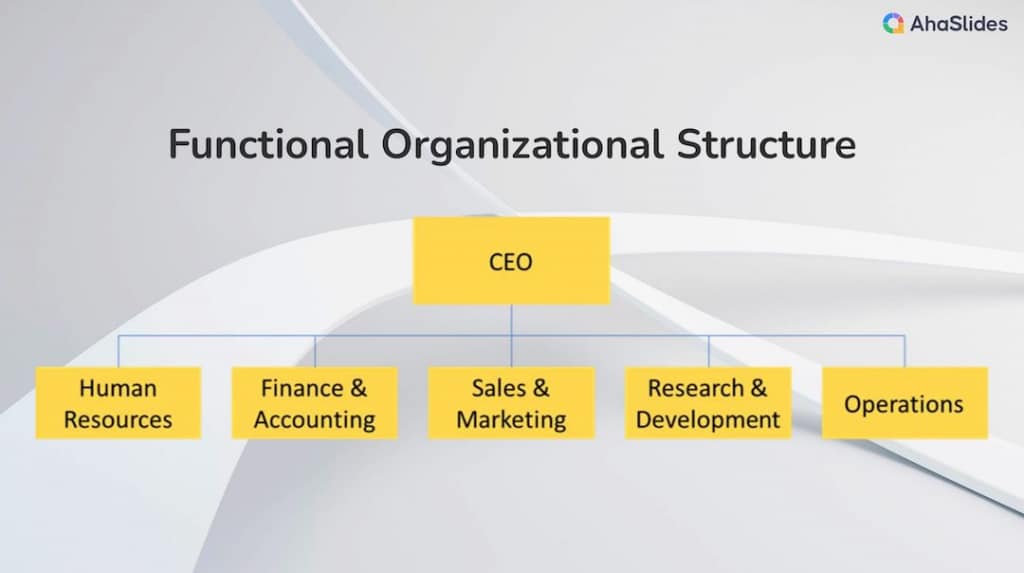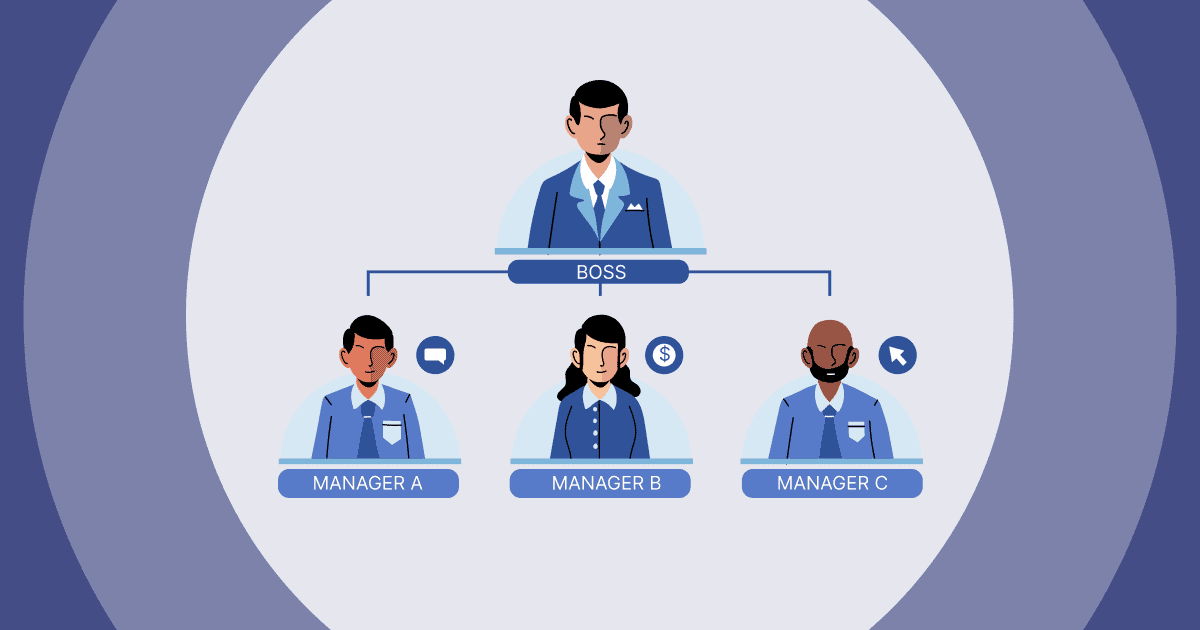هل تساءلت يومًا كيف تنظم الشركات الكبيرة نفسها وسط كل الأجزاء المتحركة؟
في حين أن بعض الشركات تعمل كوحدة واحدة متماسكة، فإن العديد منها ينشئ أقسامًا متميزة بناءً على الوظيفة. يُعرف هذا باسم أ الهيكل التنظيمي الوظيفي.
سواء كان الأمر يتعلق بالتسويق أو التمويل أو العمليات أو تكنولوجيا المعلومات، فإن الهياكل الوظيفية تقسم الفرق حسب التخصص.
ظاهريًا، يبدو هذا الفصل بين الواجبات واضحًا - ولكن كيف يؤثر ذلك حقًا على التعاون واتخاذ القرار والأعمال بشكل عام؟
في هذا المنشور، سنلقي نظرة على غطاء النموذج الوظيفي وفوائده. الغوص في الحق!
| ما هي أمثلة التنظيم الوظيفي؟ | قابلة للتطوير، ستاربكس، أمازون. |
| ما هو نوع التنظيم المناسب للهيكل التنظيمي الوظيفي؟ | الشركات الكبيرة. |
جدول المحتويات
- ما هو الهيكل التنظيمي الوظيفي؟
- مزايا الهيكل التنظيمي الوظيفي
- عيوب الهيكل التنظيمي الوظيفي
- التغلب على تحديات الهيكل التنظيمي الوظيفي
- متى يكون الهيكل الوظيفي مناسبا؟
- أمثلة على الهيكل التنظيمي الوظيفي
- الوجبات السريعة الرئيسية
- الأسئلة الشائعة
مزيد من النصائح مع AhaSlides

هل تبحث عن المزيد من المرح أثناء التجمعات؟
اجمع أعضاء فريقك من خلال اختبار ممتع على AhaSlides. قم بالتسجيل لأخذ اختبار مجاني من مكتبة قوالب AhaSlides!
🚀 احصل على مسابقة مجانية
ما هو الهيكل التنظيمي الوظيفي؟

تختار العديد من الشركات تنظيم نفسها في أقسام مختلفة بناءً على أنواع الوظائف أو المهام التي يقوم بها الأشخاص، وتقسيم العمل إلى وظائف أكثر تخصصًا.
هذا ما يسمى بـ "امتلاك"الهيكل التنظيمي الوظيفيبدلاً من تجميع جميع العاملين في نفس المشروع معًا، يتم تجميع الأشخاص حسب مجال عملهم العام - مثل التسويق، والمالية، والعمليات، وخدمة العملاء، وما إلى ذلك.
على سبيل المثال، كل من يقوم بإنشاء إعلانات، أو يدير حملات على وسائل التواصل الاجتماعي، أو يفكر في أفكار منتجات جديدة سيكون في قسم التسويق. جميع المحاسبين الذين يتتبعون الأموال ويدفعون الفواتير ويقدمون الضرائب سيكونون معًا في مجال التمويل. سيعمل المهندسون جنبًا إلى جنب مع مهندسين آخرين في العمليات.
الفكرة هي أنه من خلال جمع جميع الموظفين ذوي المهارات الوظيفية المتشابهة، يمكنهم مساعدة بعضهم البعض والتعلم من خبراتهم. كما يمكن توحيد إجراءات مثل الإجراءات المالية في جميع أقسام القسم.
هذا الهيكل يجعله فعالاً للغاية، إذ لا يضطر المتخصصون للبحث باستمرار عن إجابات خارج أقسامهم. ولكنه قد يُصعّب أيضاً على مختلف الأقسام التعاون بشكل جيد في مشاريع أكبر تتطلب مهارات متعددة. كما قد ينقطع التواصل بين الأقسام أحياناً.
بشكل عام، تعد الهياكل الوظيفية جيدة للشركات القائمة حيث يتم تحديد العمليات، ولكن تحتاج الشركات إلى إيجاد طرق لجمع الأشخاص معًا عبر الإدارات أيضًا لتجنب العمل بمفردهم الصوامع كثير جدا.
مزايا الهيكل التنظيمي الوظيفي

يتم استكشاف الفوائد الرئيسية للهيكل التنظيمي الوظيفي أدناه:
- التخصص في العمل - يكتسب الأفراد الخبرة في وظائفهم المحددة بالتركيز على تلك المهام فقط، مما يؤدي إلى زيادة الإنتاجية.
- مركزية الخبرات - تُجمع الخبرات المتشابهة داخل كل قسم، ما يُتيح للموظفين التعلّم من بعضهم البعض ودعم بعضهم البعض.
- توحيد الممارسات - يمكن تطوير طرق عمل مشتركة وتوثيقها داخل كل وظيفة لتحقيق الاتساق.
- خطوط واضحة للتقارير - من الواضح من يتبعه الموظفون حسب أدوارهم، دون الحاجة إلى تقارير مصفوفية لعدة مدراء. هذا يُسهّل عملية اتخاذ القرار.
- التخصيص المرن للموارد - يمكن نقل العمالة ورأس المال بسهولة أكبر داخل الأقسام بناءً على الأولويات المتغيرة وحجم العمل.
- اقتصاديات الحجم - يمكن مشاركة الموارد مثل المعدات والموظفين داخل كل قسم، مما يقلل التكاليف لكل وحدة إنتاج.
- سهولة مراقبة الأداء - يمكن ربط مقاييس القسم بالأهداف والنتائج بشكل أكثر وضوحًا نظرًا لأن الوظائف منفصلة.
- فرص التطوير المهني - يمكن للموظفين تطوير مهاراتهم ومساراتهم المهنية من خلال التنقل بين الأدوار ضمن مجال تخصصهم.
- تبسيط الإدارة – يتمتع كل رئيس قسم بسلطة على وحدة متجانسة واحدة، مما يجعل الإدارة أقل تعقيدًا.
باختصار، يعزز الهيكل الوظيفي التخصص والاستفادة من الخبرة والكفاءة التشغيلية ضمن الوظائف الفردية.
عيوب الهيكل التنظيمي الوظيفي

وعلى الجانب الآخر من العملة، فإن الهيكل التنظيمي الوظيفي ليس خاليًا من العيوب تمامًا. يجب على الشركات أن تأخذ في الاعتبار هذه النكسات المحتملة:
- عقلية الصومعة - قد تركز الأقسام على أهدافها الخاصة بدلًا من أهداف المنظمة ككل، مما يعيق التعاون.
- تكرار الجهود - قد يتم تنفيذ نفس المهام بشكل متكرر في أقسام مختلفة بدلاً من تبسيطها عبر الوظائف.
- بطء عملية اتخاذ القرار - تستغرق القضايا التي تتقاطع مع الأقسام وقتًا أطول لحلها لأنها تتطلب التنسيق بين الأقسام المختلفة.
- خدمة العملاء سيئة - قد يتلقى العملاء الذين يتفاعلون مع أقسام متعددة تجربة غير متسقة أو مجزأة.
- العمليات المعقدة - يمكن أن يصبح العمل الذي يتطلب تعاونًا بين مختلف الوظائف متشابكًا وغير فعال ومحبطًا.
- عدم المرونة في التغيير - من الصعب تحويل الموارد ومواءمتها بسرعة عندما تتغير احتياجات السوق أو تظهر فرص جديدة.
- صعوبة تقييم التنازلات - قد يتم تجاهل التأثيرات الأوسع للقرارات الوظيفية دون مراعاة الترابطات المتبادلة.
- الإفراط في الاعتماد على المشرفين – يعتمد الموظفون بشكل كبير على قائد قسمهم بدلاً من تطوير منظور الصورة الكبيرة.
- الابتكار المكبوت - إن الأفكار الجديدة التي تتطلب مدخلات من مجالات مختلفة تواجه صعوبة أكبر في الحصول على الدعم.
يمكن للصوامع الوظيفية، وبطء اتخاذ القرار، ونقص التعاون أن يقوض الكفاءة والمرونة للمؤسسة التي لديها هذا الهيكل.
التغلب على تحديات الهيكل التنظيمي الوظيفي
قد يكون من الصعب على فرق العمل المختلفة، مثل التسويق والمبيعات والدعم، التواصل إذا كانت كلٌّ منها تعمل في مكانها الخاص. لكن العزلة في الواقع تُصعّب إنجاز المهام. إليك بعض الأفكار للتغلب على هذه التحديات:
قم بعمل مشاريع مع أشخاص من مناطق مختلفة. هذا يقدم الجميع ويجعلهم يساعدون بعضهم البعض.
اختر أشخاصًا لمساعدة الوحدات على الارتباط. قم بتعيين مديري المنتج/العميل، وسيتأكدون من مشاركة الجميع للتحديثات وحل المشكلات معًا.
ركز على الأهداف المشتركة، بدلًا من أن تقوم كل منطقة بعملها الخاص، وتوافق مع أحلام الشركات الكبيرة التي يدعمونها جميعًا.
قم بتوحيد الأدوار المكررة مثل الموارد البشرية أو تكنولوجيا المعلومات بحيث يخدم فريق واحد الجميع مقابل تقسيم العمل.
نظّم اجتماعاتٍ تُطلع فيها المناطق بعضها البعض على آخر المستجدات. حارب المشاكل من جذورها.

استثمر في أدوات التعاون - يمكن للتقنيات مثل الشبكات الداخلية، ومشاركة المستندات/الملفات، أو تطبيقات إدارة المشاريع أن تسهل التنسيق.
تعزيز التناوبات المرنة. اسمح للموظفين بتجربة أدوار أخرى في مكان آخر بشكل مؤقت لفهم بعضهم البعض بشكل أفضل وتطوير منظور مختلف.
تتبع العمل الجماعي أيضًا. انتبه لمدى انسجام الأفراد ومؤشرات الأداء الرئيسية للفريق، وليس فقط الإنجازات الفردية. امنح القادة حوافز للتركيز على التآزر التنظيمي، وليس فقط مؤشرات الأداء الرئيسية الوظيفية.
وأخيرًا، قم بتشجيع التفاعل الاجتماعي حتى يصبح كل قسم أكثر راحة في التواصل مع بعضهم البعض للحصول على المساعدة. إن إيجاد طرق للتفاعل بين الوظائف والعمل ككل مترابط سيساعد في كسر العزلة.
كسر الجليد مع AhaSlides
ساعد كل قسم على التواصل والترابط من خلال أنشطة AhaSlides التفاعلية. أساسي لجلسات تعزيز الترابط بين الشركات!🤝

متى يكون الهيكل الوظيفي مناسبا؟

تحقق من القائمة لمعرفة ما إذا كانت مؤسستك مناسبة لتشكيل هذا الهيكل:
☐ الشركات الراسخة ذات العمليات الموحدة - بالنسبة للشركات الناضجة التي تكون عملياتها الأساسية وسير العمل فيها محددة جيدًا، فإن التخصص داخل الوظائف يمكن أن يعزز الكفاءة.
☐ بيئة عمل مستقرة - إذا كانت احتياجات السوق والعملاء قابلة للتنبؤ نسبيًا، فيمكن للمجموعات الوظيفية التركيز على تحسين مجالاتها المتخصصة دون الحاجة إلى التعاون السريع بين الأقسام.
☐ المهام التي تتطلب خبرة متخصصة - تعتمد بعض الوظائف مثل الهندسة أو المحاسبة أو العمل القانوني بشكل كبير على المهارات التقنية العميقة وهي مناسبة تمامًا للهيكل الوظيفي.
☐ إعطاء الأولوية للتنفيذ التشغيلي - تكون الهياكل الوظيفية فعالة للغاية عندما تعطي المنظمة الأولوية لإنتاج أو تقديم منتج أو خدمة؛ إن فصل الخطوات المتخصصة بين الوظائف يمكن أن يؤدي إلى تبسيط التنفيذ.
☐ المنظمات الكبيرة ذات الحجم الكبير - قد تقوم الشركات الكبيرة جدًا التي تضم آلاف الموظفين بتنظيم نفسها في وظائف فقط لإدارة التعقيد عبر وحدات الأعمال المتعددة.
☐ تخصيص الموارد هو الأكثر أهمية - بالنسبة للصناعات كثيفة رأس المال، فإن الهيكل الذي يسهل التخصيص الدقيق للموارد والمعدات المتخصصة يعمل بشكل جيد.
☐ الثقافات البيروقراطية التقليدية - تفضل بعض الشركات الراسخة أنظمة إدارية مقسمة إلى أقسام كبيرة من أجل التحكم والإشراف.
أمثلة على الهيكل التنظيمي الوظيفي

شركة التكنولوجيا:
- قسم التسويق
- قسم الهندسة
- قسم تطوير المنتجات
- قسم تكنولوجيا المعلومات / العمليات
- قسم المبيعات
- قسم دعم العملاء
شركة تصنيع:
- قسم الإنتاج/العمليات
- قسم الهندسة
- قسم المشتريات
- قسم التحكم في الجودة
- قسم اللوجستيات/التوزيع
- قسم المبيعات والتسويق
- قسم المالية والمحاسبة
المستشفى:
- قسم التمريض
- قسم الأشعة
- قسم الجراحة
- قسم المختبرات
- قسم الصيدلة
- القسم الإداري/الفوترة
متجر البيع بالتجزئه:
- قسم عمليات المتجر
- قسم التجارة / الشراء
- قسم التسويق
- قسم المالية/المحاسبة
- قسم الموارد البشرية
- قسم منع الخسائر
- قسم تكنولوجيا المعلومات
جامعة:
- الأقسام الأكاديمية المختلفة مثل الأحياء واللغة الإنجليزية والتاريخ وما إلى ذلك
- قسم شؤون الطلاب
- قسم المرافق
- قسم الأبحاث المدعومة
- قسم ألعاب القوى
- الدائرة المالية والإدارية
هذه بعض الأمثلة على كيفية قيام الشركات في الصناعات المختلفة بتجميع الأدوار والوظائف المتخصصة في الأقسام لتشكيل هيكل تنظيمي وظيفي.
الوجبات السريعة الرئيسية
رغم فوائد تقسيم العمل إلى أقسام متخصصة، إلا أنه من السهل تشكّل صوامع بين المجموعات. وللنجاح الحقيقي، تحتاج الشركات إلى التعاون بقدر ما تحتاج إلى التخصصات.
في نهاية المطاف، جميعنا في فريق واحد. سواءً كنتَ تُصنّع المنتجات أو تُقدّم خدمة عملاء، فإن عملك يدعم الآخرين ويدعم رسالة الشركة بشكل عام.
؟؟؟؟ شاهد أيضاً: أكثر من 7 أنواع من الهيكل التنظيمي تحتاج الى ان تعرف.
الأسئلة الشائعة
ما هي الهياكل التنظيمية الوظيفية الأربعة؟
الهياكل التنظيمية الوظيفية الأربعة هي الهيكل الوظيفي، والأقسام، والمصفوفة، والشبكة.
ما المقصود بالهيكل الوظيفي؟
يشير الهيكل التنظيمي الوظيفي إلى كيفية تقسيم الشركة لعمالها وإداراتها بناءً على الوظائف أو خطوط العمل المعنية أثناء التشغيل.
هل ماكدونالدز لديه هيكل تنظيمي وظيفي؟
لدى ماكدونالدز هيكل تنظيمي تقسيمي حيث يخدم كل قسم موقعًا جغرافيًا محددًا ويعمل بشكل مستقل تقريبًا مع أقسامه المنفصلة مثل التسويق والمبيعات والمالية والقانونية والإمداد وما إلى ذلك.







